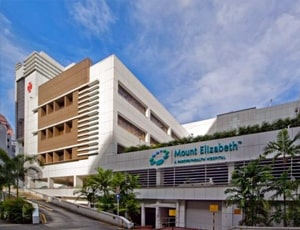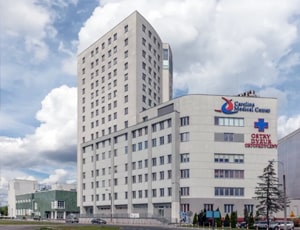Laminectomy is also known as “decompression surgery”. In this surgical procedure, a part of the vertebral bone called lamina is removed to create additional space. The lamina is the back part of the vertebrae that covers the spinal canal. Removing the lamina enlarges the spinal canal and thus, helps relieve pressure on the nerves and the spinal cord. Bony growths, especially in people with spinal arthritis, may put additional pressure on the spinal cord. It may cause severe back pain and in some severe cases, can even cause paralysis. Narrowing of the space between the vertebrae is also known as spinal stenosis.
Laminectomy surgery, which is a form of spinal stenosis treatment, helps relieve pressure on the spinal cord and the nerves by creating a room between the vertebrae and the cord. When the pressure on the spinal cord in the case of lumbar spinal stenosis is relieved by creating a space between the lumbar vertebrae, the procedure is known as a lumbar laminectomy. During a lumbar laminectomy, the surgeon may even remove the ligaments or bone spurs pressing the spinal cord.
Before considering a laminectomy, individuals may experience symptoms related to spinal stenosis, herniated discs, or other conditions that lead to pressure on the spinal cord and nerves.
Common signs and symptoms that might prompt a healthcare provider to recommend laminectomy include:
Before undergoing a laminectomy, several diagnostic tests are typically conducted to assess the condition of the spine and determine the appropriateness of the procedure. Common diagnostic tests before laminectomy include:
Laminectomy is typically done with general anesthesia, meaning you're unconscious during the procedure. The surgical team keeps an eye on your heart rate, blood pressure, and oxygen levels throughout. Once you're asleep and can't feel anything:
The surgeon makes a cut in your back over the affected area, moving muscles away to reach the spine. They use small tools to remove bone spurs and just the necessary amount of lamina. The incision size depends on your condition and body size, with minimally invasive surgeries using smaller cuts.
If the laminectomy is part of treating a herniated disk, the surgeon also removes the herniated part and any loose pieces (diskectomy). For issues like a slipped vertebra or spine curvature, spinal fusion may be necessary to stabilize the spine. This involves permanently connecting two or more vertebrae after removing arthritic joints. Bone grafts and, if needed, metal rods and screws may be used. Depending on your situation, the surgeon might use a smaller incision (minimally invasive) and a special microscope for the operation.
Laminectomy surgery takes anywhere between two to three hours to complete. The loss of blood during the surgery is minimal. Shortly after the surgery, the patient is moved to the recovery room. After a few hours, the patient is transferred to the normal hospital room. The patient can expect the following things after the surgery:
The timeline for returning to work varies, influenced by the demands of your job. Depending on factors like lifting, walking, and sitting requirements, some individuals may find themselves back at work within a few weeks. However, if your procedure also involves spinal fusion, a more extended recovery period may be necessary.
Remember, adherence to post-surgery instructions is key. These guidelines, coupled with regular follow-up appointments, contribute to a well-managed recovery process. Factors such as age, overall health, and the extent of the surgery all play a role, making each individual's recovery unique. Open and ongoing communication with your healthcare team ensures that your questions and concerns are addressed throughout this recovery journey.

Singapore, Singapore
Mount Elizabeth Hospital is a multispecialty healthcare facility operated by Parkway Health. The hos...more
![]() Private Driver / Limousine Services
Private Driver / Limousine Services
![]() International Cuisine
International Cuisine
![]() Phone in Room
Phone in Room
![]() Online Doctor Consultation
Online Doctor Consultation

Warsaw, Poland
History Carolina Medical Center is one of the best and clinically advanced orthopedics and sports m...more
![]() Airport Transfer
Airport Transfer
![]() Choice of Meals
Choice of Meals
![]() Interpreter
Interpreter
![]() SIM
SIM

Tel Aviv, Israel
Assuta Medical Center is a leading private hospital in the capital city of Tel Aviv in Israel. Assut...more
![]() Airport Transfer
Airport Transfer
![]() Choice of Meals
Choice of Meals
![]() Interpreter
Interpreter
![]() TV inside room
TV inside room

Neurosurgeon
Ghaziabad, India
18 Years of experience
USD 22 for video consultation

Neurosurgeon
Istanbul, Turkey
7 of experience
USD 295 for video consultation

Neurosurgeon
Istanbul, Turkey
20 Years of experience
USD 200 for video consultation

Spine & Neurosurgeon
Noida, India
20 Years of experience
USD 36 for video consultation
Q: How dangerous is laminectomy?
A: Laminectomy is a relatively safe procedure. Complications such as nerve root damage and paralysis are extremely rare.
Q: What is post-laminectomy pain syndrome?
A: This is characterized by persistent pain in the back following the laminectomy surgery. It is also known as failed back surgery syndrome. The surgeons may advise medications or a second surgery to treat it.
Q: How long does it take to recover from lumbar laminectomy?
A: It may take anywhere between four and six weeks to recover from the surgery.